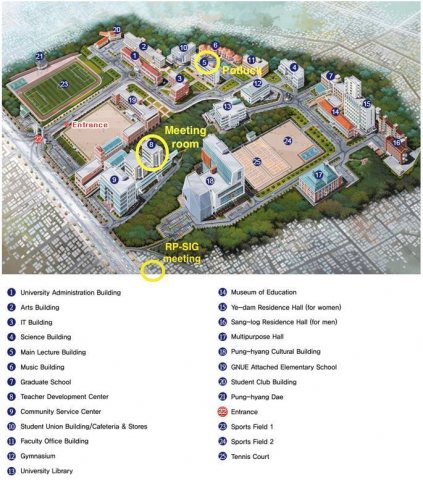
Gwangju-Jeonnam Chapter June Meeting
.
––– Morning Reflective Practice Session –––
Time: 11:00 am - 12:30 pm (3rd Sat., June 10)
NEW Location: Coffee Lab Mujii (formerly Aldersgate. NOT at Kenya Espresso Cafe), near GNUE. (Ground floor of 광주우리교회 Building. Map at bottom.)
ㅡ Topic: Non-Violent Communication II
ㅡ Facilitator: Dana Han
––– MAIN MEETING SCHEDULE –––
Time: 2nd Saturday, June 10, 2017, 1:45 - 5:00 pm
Location: Gwangju National University of Education (GNUE), Teacher Training Center (교사교육센터) 1st Floor; Room 811. Detailed directions HERE.
1:45 pm: Sign-in and Meet-and-Greet (Admission: Free for first-time attendees. Membership welcomed.)
2:00 - 2:50 pm: Presentation 1
ㅡ Teaching Figurative Language: A Workshop
ㅡ Cara Scott (Chonnam National University)
2:50 - 3:15 pm: Refreshment Break
3:15 - 4:05 pm: Presentation 2
ㅡ Thinking Critically about Critical Thinking: A Collaborative Workshop
ㅡ David Shaffer (Gwangju)
4:15 - 4:45 pm: Swap-Shop Presentations
Share your Teaching Ideas, Classroom Activities, and Teaching Wisdom with the group.
(Everyone is encouraged to share [up to 5-6 min. each]. Short tidbits are welcomed. Handouts also welcomed.)
4:45 - 5:00 pm: Announcements / Drawing for Door Prizes / Closing
Presentation Summaries and Presenter Biodata
Teaching Figurative Language: A Workshop
By Cara Scott
Can language be taught without the introduction of culture? Teaching figurative language such as metaphors can be challenging even within a student’s native language; for second language learners, it can feel like an impossible task. This does not mean that teachers and learners should feel discouraged. The English language is very idiomatic, and everyday speech is often filled with figurative expressions such as idioms and metaphors. Some research has shown that raising metaphor awareness is beneficial to English learners’ sensitivity to figurative language.
How can we, as teachers, approach teaching figurative language in the classroom? This workshop will strive to bring together a collaboration of minds to address this question. Participants will come together and discuss approaches to introducing metaphors and other figurative language in the classroom.
The Presenter

Cara Scott was born and raised in Washington State, in the United States and attended Central Washington University. She has lived and worked in South Korea since 2012, teaching students ranging from elementary to university. For the past two years, Cara has worked at Chonnam National University in Gwangju City. Currently, she is researching the effect of extensive reading and English literature on EFL learners.
____________________
Thinking Critically about Critical Thinking: A Collaborative Workshop
David Shaffer facilitating
Critically thinking is a ELT buzzword that has been around for more than two decades, yet are we confident that we fully understand it? Explanations are often opaque and perplexing, but this Halvorsen (2005) definition seems both simple and clear:
To think critically about an issue is (a) to consider that issue from various perspectives, (b) to look at and challenge any possible assumptions that may underlie the issue and (c) to explore its possible alternatives.
Teachers may neglect trying to incorporate critical thinking into their lessons, considering it too difficult to deal with, which usually arises from not fully understanding the concept or not fully understanding how to present it to students. However, "research on critical thinking shows that it not only can be taught but must be taught" (Schmidt, 2016). As educators, we should help our students develop this skill by providing them with activities that require the use of critical thinking and by providing them with strategies to develop this skill.
Not only can critical thinking be taught, it can be practiced and refined. Here is some practical advice:
- Examples of critical thinking are not enough – students need to engage in critical thinking.
- There needs to be deliberate practice to master the skill. This includes full concentration, exercises aimed at improving the skills, engaging in increasingly difficult exercises as easier ones are mastered, and guidance and feedback.
- The practice must be repetitive throughout a course.
- Students must practice transferring critical thinking skills to other contexts.
- Students must eventually become aware of the actual idea of critical thinking, including its terminology.
.
In this collaborative workshop, we will work is small groups to create an activity that effectively incorporates critical thinking. the aspect to be taught and the student age/proficiency level will be given to each group. For example:
ㅡ Teaching Point: Making Requests
ㅡ Elementary School, grades 3-4
ㅡ Proficiency Level: Beginner
Groups will be given about 12 minutes to create their activity and then will describe it to the whole group. Groups will then exchange their activities/tasks and try to improve upon the original activity or create another activity altogether in about 12 minutes. These results will then be presented to the whole group.

____________________
Photo: The Gwangju National University of Education (GNUE / 광주교육대학교), Teacher Training Center (교사교육센터), venue for our main meeting - 1st floor, Room 811.




